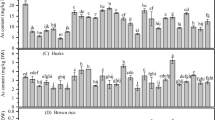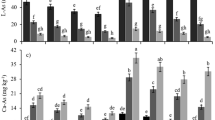Abstract
Arsenic (As) sorptivity and acetate (pH 4.8) and oxalate (pH 3.0) extractable iron levels were monitored for 180 d, during and after flooding of two As contaminated soils. The effects of three different organic matter supplements/amendments, for example farm yard manure (FYM), municipal solid waste compost (MSWC) and sewage-sludge (SS) on the above parameter were also examined. In nonflooded soils, As sorptivity was mainly influenced by clay content. On flooding, there were large increases in acetate, oxalate extractable iron and As sorptivity. Organic matter addition increased the same parameters. Among the organic matters, SS showed greater effect on As sorption followed by MSWC and FYM. During flooding, As sorption is mainly dependent upon poorly crystalline iron oxide. During oxidation of previously flooded soils, levels of As sorptivity, acetate and oxalate extractable iron decreased rapidly, but did not return to the levels occurring before reduction. SS and MSWC served as binding agents for native and irrigation water As, thereby moderating the rapid As mobilization to the crop rizosphere.




Similar content being viewed by others
References
Alloway BJ (1990) Heavy metals in soils. Blackie, Glasgow, UK
Bache BW, Williams EG (1971) A phosphate sorption index for soils. J Soil Sci 22:289–301
Bhattacharyya P, Chakrabarti K, Chakraborty A,Bhattacharya B (2001) Microbial biomass and activities of soils amended with municipal solid waste compost. J Ind Soc Soil Sci 49(1):98–104
Carbonell-Barrachina AA, Jugsujinda A, DeLaune RD, Patrick WH Jr (1999) The influence of redox chemistry and pH on chemically active forms of As in sewage sludge-amended soil. Env Int 25:613–618
Frost RR, Griffin RA (1977) Effect of pH on adsorption of As and selenium from land fill leachate by clay minerals. Soil Sci Soc Am J 41:53–57
Ghosh AK, Sarkar D, Sanyal SK, Nayak DC (2002) Status and distribution of As in alluvium derived soils of West Bengal and their interrelationship with some soil properties. J Ind Soc Soil Sci 50:51–56
Harada Y, Inoko A (1980) The measurement of the cation-exchange capacity of composts for the estimation of the degree of maturity. Soil Sci Plant Nutr 26:127–134
Huang PM (1975) Retention of As by hydroxy: aluminium on surfaces of micaceous mineral colloids. Soil Sci Soc Am J 39:271–274
Juwarkar AS, Shende A, Thwale PR, Satyanarayanan, Desabratar PB, Bal AS, Juwarkar A (1992) Biological and industrial wastes as sources of plant nutrients. In: Tandon HLS (ed) Fertiliser, organic manures, recyclable wastes and biofertilizers, Fertilizer Development and Consultation Organization, New Delhi, India, pp 72–90
Manful GA, Verloo M, De Spiegeleer F (1989) Arsenate sorption by soils in relation to pH and selected anions. Pedologie 39:55–68
McKeague JA, Day JH (1966) Dithionite and oxalate extractable Fe and Al as aids in differentiating various classes of soils. Can J Soil Sci 46:13–21
McGeehan SL, Fendorf SE, Naylor DV (1998) Alteration of As sorption in flooded–dried soils. Soil Sci Soc Am J 62:828–833
Mehra OP, Jackson ML (1960) Iron oxide removal from soils and clays by a dithionite–citrate system buffered with sodium bicarbonate. Clays Clay Miner 7:317–327
Nelson DW, Sommers LF (1975) A rapid and accurate method for estimating organic carbon in soil. Proc Indiana Acad Sci 84:456–462
Onken BM, Hossner LR (1995) Plant uptake and determination of As species in soil solution under flooded conditions. J Environ Qual 24:373–381
Page AL, Miller RH, Keeney DR (1982) Methods of soil analysis, Part 2, (2nd edn) Soil Science Society of America, Madison, USA
Piper CS (1966) Soil and plant analysis, Maver, Bombay
Ponnamperuma FN (1972) The chemistry of submerged soils. Adv Agron 24:26–92
Ponnamperuma FN, Tianco EM, Loy T (1967) Redox eqilibria in flooded soils, I. The iron hydroxide systems. Soil Sci 103:374–382
Sankaram A (1966) A laboratory manual for agricultural chemistry. Asia Publishing House, Calcutta
Stratton ML, Barker AV, Rechcigl JE (1995) Compost. In: Rechcigl JE (ed) Soil amendments and environmental quality. Lewis, New York
Willett IR, Higgins ML (1980) Phosphate sorption and extractable iron during irrigated rice-upland crop rotations. Aust J Exp Agric Anim Husb 20:346–353
World Health Organisation (WHO) (1996) Guidelines for drinking water quality: health criteria and other supporting information. ( vol 2, 2nd Edn) Geneva
Author information
Authors and Affiliations
Corresponding author
Rights and permissions
About this article
Cite this article
Ghosh, A.K., Bhattacharyya, P. Arsenate sorption by reduced and reoxidised rice soils under the influence of organic matter amendments. Env Geol 45, 1010–1016 (2004). https://doi.org/10.1007/s00254-004-0961-z
Received:
Accepted:
Published:
Issue Date:
DOI: https://doi.org/10.1007/s00254-004-0961-z




